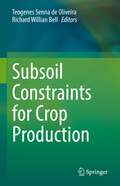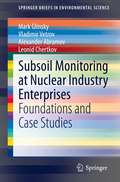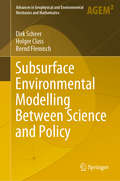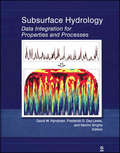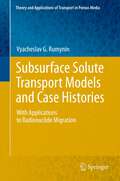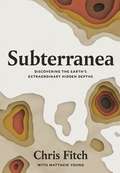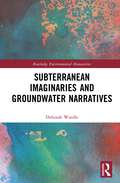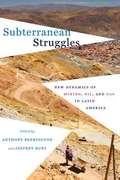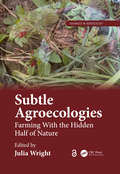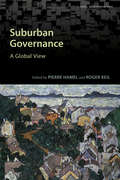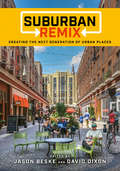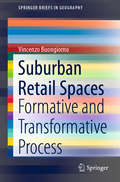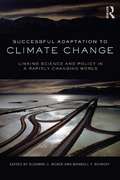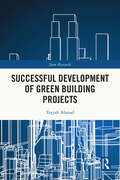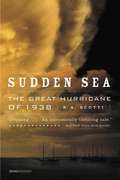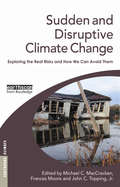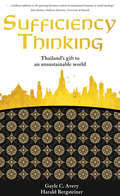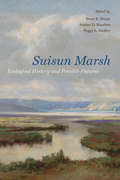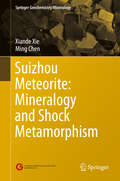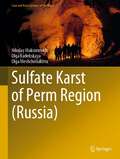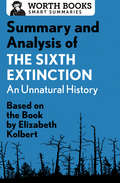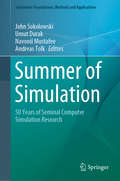- Table View
- List View
Subsoil Constraints for Crop Production
by Teogenes Senna de Oliveira Richard Willian BellThis book will address the major subsoil physical and chemical constraints and their implications to crop production; Plant growth is often restricted by adverse physical and chemical properties of subsoils yet these limitations are not revealed by testing surface soils and hence their significance in crop management is often overlooked. The major constraints can be physical or chemical. Physical limitations such as poor/nil subsoil structure, sandy subsoils that do not provide adequate water or gravelly subsoils and, etc. On the other hand, chemical constraints include acidity/alkalinity, high extractable Al or Mn, low nutrient availability, salts, boron toxicity and pyritic subsoils. Some of these constraints are inherent properties of the soil profile while others are induced by crop and soil management practices. This aim of this book is to define the constraints and discuss amelioration practices and benefits for crop production. This book will be of interest to readers involved with agriculture and soil sciences in laboratory, applied or classroom settings.
Subsoil Monitoring at Nuclear Industry Enterprises: Foundations and Case Studies (SpringerBriefs in Environmental Science)
by Mark Glinsky Vladimir Vetrov Alexander Abramov Leonid ChertkovThis book is the first comprehensive review of the subsurface monitoring theory and practice. It presents all aspects of a subsurface monitoring system SM-NI to be organized in impacted areas of nuclear industry enterprises. The content of the book covers the whole set of the SM-NI projecting and implementation issues – from the theoretical and regulatory framework, through the description of the sources of impact on geological environment to examples of use the SM-NI to solve environmental problems on the main types of environmentally significant nuclear industry enterprises. Development of the SM-NI was based on long-term research studies including modeling of pollutants transport in the geological environment.The book is intended for a wide range of nuclear industry employees and specialists in environment protection and radiation safety of nuclear industry enterprises. It might be useful for ecologists, students and postgraduates concerned about environment protection in the field of nuclear technology
Subsurface Environmental Modelling Between Science and Policy (Advances in Geophysical and Environmental Mechanics and Mathematics)
by Dirk Scheer Holger Class Bernd FlemischThis book provides a broad overview of essential features of subsurface environmental modelling at the science-policy interface, offering insights into the potential challenges in the field of subsurface flow and transport, as well as the corresponding computational modelling and its impact on the area of policy- and decision-making. The book is divided into two parts: Part I presents models, methods and software at the science-policy interface. Building on this, Part II illustrates the specifications using detailed case studies of subsurface environmental modelling. It also includes a systematic research overview and discusses the anthropogenic use of the subsurface, with a particular focus on energy-related technologies, such as carbon sequestration, geothermal technologies, fluid and energy storage, nuclear waste disposal, and unconventional oil and gas recovery.
Subsurface Hydrology: Data Integration for Properties and Processes (Geophysical Monograph Series #171)
by David W. Hyndman Frederick D. Day-Lewis Kamini SinghaPublished by the American Geophysical Union as part of the Geophysical Monograph Series, Volume 171.Groundwater is a critical resource and the PrinciPal source of drinking water for over 1.5 billion people. In 2001, the National Research Council cited as a "grand challenge" our need to understand the processes that control water movement in the subsurface. This volume faces that challenge in terms of data integration between complex, multi-scale hydrologie processes, and their links to other physical, chemical, and biological processes at multiple scales. Subsurface Hydrology: Data Integration for Properties and Processes presents the current state of the science in four aspects: Approaches to hydrologie data integration Data integration for characterization of hydrologie properties Data integration for understanding hydrologie processes Meta-analysis of current interpretations Scientists and researchers in the field, the laboratory, and the classroom will find this work an important resource in advancing our understanding of subsurface water movement.
Subsurface Solute Transport Models and Case Histories
by Vyacheslav G. RumyninThe book addresses the development of the basic knowledge of the subsurface solute transfer with a particular emphasis on field data collection and analysis coupled with modeling (analytical and numerical) tool application. The relevant theoretical developments are concerned mainly with the formulation and solution of deterministic mass-transport equations for a wide range of engineering issues in groundwater quality assessment and forecasting. The book gives many computational examples and case studies drawn from the conducted field investigations. The analyzed problems are as follows: investigation and prediction of groundwater contamination by industrial contaminants and solutions (radionuclides, chloride and nitrate brine) with special focus on the effect of (a) aquifer heterogeneity, anisotropy, and dual porosity, (b) density contrast existing between industrial waste and groundwater, or in density-stratified artesian and coastal groundwater systems; (c) physicochemical interactions that play a major role in retarding (e.g. adsorption) or enhancing (e.g. interactions between dissolved species and mobile colloids) contaminant transport;prediction of the effects of pumping on groundwater quality at wellfields;groundwater dating using stable and radioactive isotopes for prediction and assessment of contamination potential;field and laboratory tests' design and analysis, and monitoring data interpretation;partitioning of surface and subsurface flows using isotope techniques.One of the most essential topics addressed in the book is the migration and fate of radionuclides. Model development is motivated by field data analysis from a number of radioactively contaminated sites in the Russian Federation: near-surface radioactive waste disposal sites and deep-well radioactive waste injection sites. They play a unique role in the advancement of knowledge of the subsurface behavior and fate of many hazardous radionuclides and can be considered as field-scale laboratories. Thus, the book, along with theoretical findings, contains field information, which will facilitate the understanding of subsurface solute transport and the development of a methodology for practical applications to groundwater hydrology.
Subterranea: Discovering the Earth's Extraordinary Hidden Depths
by Chris Fitch'AN ORIGINAL AND TIMELY ODYSSEY INTO OUR MYSTERIOUS UNDERWORLD . . . THRILLING PROOF THAT SCIENCE AND IMAGINATION SHARE THE GROUND BENEATH OUR FEET' Nicholas Crane, presenter of BBC2's Coast and Great British JourneysIf you were to peel back the Earth's surface like an orange, then take a sly peek underneath, what extraordinary things would you see?Subterranea is where the world's remaining mysteries are yet to be found. For millennia, across nations and cultures, it has been a hotbed of fantastical stories. It's where humans have kept their most sacred treasures and their darkest secrets. It's where we have found evidence of our past and may, at some point, find an escape route for our uncertain future. But what would we find there today? From the underground cities of Cappadocia to smuggling tunnels on the US-Mexico border, caves full of tiny blind dragons and a seed vault located 1300km inside the Arctic circle, Subterranea demonstrates that the world below our feet is every bit as vivid and evocative as the world we see around us. Lavishly illustrated and replete with maps and photographs of little-explored locations, Subterranea is the unique, untold and utterly unforgettable story of our planet from the inside.
Subterranean Imaginaries and Groundwater Narratives (Routledge Environmental Humanities)
by Deborah WardleThis book interrogates the problems of how and why largely unseen matter, in this case groundwater, has found limited expression in climate fiction. It explores key considerations for writing groundwater narratives in the Anthropocene. The book investigates a unique selection of climate fiction alongside an exploration of hydrosocial environmental humanities through a focus on groundwater and groundwater narratives. Providing eco-critical analysis, with creative fiction and non-fiction excerpts interwoven throughout, and drawing on Indigenous Australian and Australian settler novels and poems alongside European, American and Japanese texts, the book illuminates the processes of ‘storying with’ subterranean waters – their facts, uncertainties, potencies and vulnerabilities. In a time when the water crisis in an Australian and worldwide context is escalating in response to global warming, giving voice to the complexities of groundwater extraction and pollution is vital. Drawing from non-representational, posthumanist and feminist perspectives, the book provides an important contribution to transnational, comparative climate fiction analysis, enabling an interdisciplinary exchange between hydrogeological science and the eco-humanities. This book is an engaging read for scholars and students in creative writing, environmental humanities, cultural and post-colonial studies, Australian studies, and eco-critical literary studies. Writers and thinkers addressing the problems of the Anthropocene are called to pay attention to the importance of subterranean imaginaries and groundwater narratives.
Subterranean Struggles: New Dynamics of Mining, Oil, and Gas in Latin America
by Anthony Bebbington Jeffrey BuryOver the past two decades, the extraction of nonrenewable resources in Latin America has given rise to many forms of struggle, particularly among disadvantaged populations. The first analytical collection to combine geographical and political ecological approaches to the post-1990s changes in Latin America’s extractive economy, Subterranean Struggles closely examines the factors driving this expansion and the sociopolitical, environmental, and political economic consequences it has wrought. In this analysis, more than a dozen experts explore the many facets of struggles surrounding extraction, from protests in the vicinity of extractive operations to the everyday efforts of excluded residents who try to adapt their livelihoods while industries profoundly impact their lived spaces. The book explores the implications of extractive industry for ideas of nature, region, and nation; “resource nationalism” and environmental governance; conservation, territory, and indigenous livelihoods in the Amazon and Andes; everyday life and livelihood in areas affected by small- and large-scale mining alike; and overall patterns of social mobilization across the region. Arguing that such struggles are an integral part of the new extractive economy in Latin America, the authors document the increasingly conflictive character of these interactions, raising important challenges for theory, for policy, and for social research methodologies. Featuring works by social and natural science authors, this collection offers a broad synthesis of the dynamics of extractive industry whose relevance stretches to regions beyond Latin America.
Subtle Agroecologies: Farming With the Hidden Half of Nature (Advances in Agroecology)
by Julia Wright Nicholas ParrottThis book is about the invisible or subtle nature of food and farming, and also about the nature of existence. Everything that we know (and do not know) about the physical world has a subtle counterpart which has been scarcely considered in modernist farming practice and research. If you think this book isn’t for you, if it appears more important to attend to the pressing physical challenges the world is facing before having the luxury of turning to such subtleties, then think again. For it could be precisely this worldview – the one prioritises the physical-material dimension of reality - that helped get us into this situation in the first place. Perhaps we need a different worldview to get us out? This book makes a foundational contribution to the discipline of Subtle Agroecologies, a nexus of indigenous epistemologies, multidisciplinary advances in wave-based and ethereal studies, and the science of sustainable agriculture. Not a farming system in itself, Subtle Agroecologies superimposes a non-material dimension upon existing, materially-based agroecological farming systems. Bringing together 43 authors from 12 countries and five continents, from the natural and social sciences as well as the arts and humanities, this multi-contributed book introduces the discipline, explaining its relevance and potential contribution to the field of Agroecology. Research into Subtle Agroecologies may be described as the systematic study of the nature of the invisible world as it relates to the practice of agriculture, and to do this through adapting and innovating with research methods, in particular with those of a more embodied nature, with the overall purpose of bringing and maintaining balance and harmony. Such research is an open-minded inquiry, its grounding being the lived experiences of humans working on, and with, the land over several thousand years to the present. By reclaiming and reinterpreting the perennial relationship between humans and nature, the implications would revolutionise agriculture, heralding a new wave of more sustainable farming techniques, changing our whole relationship with nature to one of real collaboration rather than control, and ultimately transforming ourselves.
Suburban Governance
by Roger Keil Pierre HamelNorth American gated communities, African squatter settlements, European housing estates, and Chinese urban villages all share one thing in common: they represent types of suburban space. As suburban growth becomes the dominant urban process of the twenty-first century, its governance poses an increasingly pressing set of global challenges.In Suburban Governance: A Global View, editors Pierre Hamel and Roger Keil have assembled a groundbreaking set of essays by leading urban scholars that assess how governance regulates the creation of the world's suburban spaces and everyday life within them. With contributors from ten countries on five continents, this collection covers the full breadth of contemporary developments in suburban governance. Examining the classic North American model of suburbia, contemporary alternatives in Europe and Latin America, and the emerging suburbanisms of Africa and Asia, Suburban Governance offers a strong analytical introduction to a vital topic in contemporary urban studies.
Suburban Remix: Creating the Next Generation of Urban Places
by David Dixon Jason BeskeThe suburban dream of a single-family house with a white picket fence no longer describes how most North Americans want to live. The dynamics that powered sprawl have all but disappeared. Instead, new forces are transforming real estate markets, reinforced by new ideas of what constitutes healthy and environmentally responsible living. Investment has flooded back to cities because dense, walkable, mixed-use urban environments offer choices that support diverse dreams. Auto-oriented, single-use suburbs have a hard time competing.Suburban Remix brings together experts in planning, urban design, real estate development, and urban policy to demonstrate how suburbs can use growing demand for urban living to renew their appeal as places to live, work, play, and invest. The case studies and analyses show how compact new urban places are already being created in suburbs to produce health, economic, and environmental benefits, and contribute to solving a growing equity crisis.Above all, Suburban Remix shows that suburbs can evolve and thrive by investing in the methods and approaches used successfully in cities. Whether next-generation suburbs grow from historic village centers (Dublin, Ohio) or emerge de novo in communities with no historic center (Tysons, Virginia), the stage is set for a new chapter of development—suburbs whose proudest feature is not a new mall but a more human-scale feel and form.
Suburban Retail Spaces: Formative and Transformative Process (SpringerBriefs in Geography)
by Vincenzo BuongiornoThis book derives from observations of the contemporary built environment and its contradictions. The suburban retail spaces, specifically the suburban shopping mall, and the changes caused by them within urban organisms are the object of the investigation synthesized in the volume. The topic is very crucial for the development of the contemporary city. It constitutes at the same time a problem (large commercial structures' spread is 'destroying' traditional commercial urban fabrics) and an opportunity (shopping malls are the most vital parts of the new suburbs and can play the role of community nucleus in urban and suburban areas). Furthermore, the spread of e-commerce forces these structures to functional and spatial transformations that brings also a new relationship with the city.The analytical reading, supplemented by generative and design projections, is carried out by using the conceptual and methodological tools of urban morphology, specifically those of the typological processual approach. From this specific point of view, the suburban shopping mall is read as an organism (a complex system characterized by mutual solidarity and interdependence among component elements) in itself, and as a sub-organisms belonging to the largest territorial organism.The book is intended to offer, to operators, scholars, researchers, professionals and students, a reading and design method, to interpret an important aspect of the contemporary built environment by analyzing the suburban commercial space case. It offers at the same time a model applicable to other specific not-commercial cases, to defining paths for further research and design developments.
Successful Adaptation to Climate Change: Linking Science and Policy in a Rapidly Changing World
by Maxwell T. Boykoff Susanne C. MoserWhat does successful adaptation look like? This is a question we are frequently asked by planners, policy makers and other professionals charged with the task of developing and implementing adaptation strategies. While adaptation is increasingly recognized as an important climate risk management strategy, and on-the-ground adaptation planning activity is becoming more common-place, there is no clear guidance as to what success would look like, what to aim for and how to judge progress. This edited volume makes significant progress toward unpacking the question of successful adaptation, offering both scientifically informed and practice-relevant answers from various sectors and regions of the world. It brings together 18 chapters from leading experts within the field to present careful analyses of different cases and situations, questioning throughout commonly avowed truisms and unspoken assumptions that have pervaded climate adaptation science and practice to date. This book offers not one answer but demonstrates how the question of success in important ways is normative and context specific. It identifies the various dimensions of success, such as economic, political, institutional, ecological, and social, explores the tensions between them, and compiles encouraging evidence that resolutions can be found. The book appraises how climatic and non-climatic stressors play a role, what role science does and can play in adaptation decision making, and how trade-offs and other concerns and priorities shape adaptation planning and implementation on the ground. This is timely interdisciplinary text sheds light on key issues that arise in on-the-ground adaptation to climate change. It bridges the gap between science and practical application of successful adaptation strategies and will be of interest to both students, academics and practitioners.
Successful Development of Green Building Projects (Spon Research)
by Tayyab AhmadFocusing on office buildings, this book explores how green building development can be managed to achieve successful project outcomes. The book starts by highlighting the special requirements of green buildings which distinguish them from traditional buildings. The book then presents a detailed discussion of the success conditions for green building projects. Highlighting 73 success conditions which have been categorized within 20 broad themes, the book reports on the findings from interviews with Green Building stakeholders from Australia, Hong Kong, Pakistan, Singapore, the United Arab Emirates, and the United Kingdom. The book demonstrates how the complexity, design methodology, and team collaboration prevalent in the delivery of successful green buildings sets them apart from traditional building projects. The book also demonstrates that success in green building delivery is generally associated with socio-technical conditions. The research reported in this book will allow project decision-makers such as clients and project team members to consider the wide range of identified success conditions to optimise project performance across its development stages and achieve successful project outcomes. Theoretically, the findings can inform future research focused on green building development, resulting in the more efficient development of green building projects that can reduce the effects of climate change and resource depletion.
Sudden Sea: The Great Hurricane of 1938
by R. A. ScottiThis spellbinding narrative, focusing on the extraordinary human drama that unfolded as an unlikely alignment of meteorological conditions conspired to bring a deadly tropical cyclone to the Northeast in the summer of 1938, summons back the most ferocious storm ever to hit the East Coast. It was a natural disaster so intense that it indelibly marked not only the lives of families across seven states but also the land itself, requiring the entire coastline map of New England to be redrawn.
Sudden and Disruptive Climate Change: Exploring the Real Risks and How We Can Avoid Them (Earthscan Climate Ser.)
by Michael C. MacCracken Frances Moore John C. Topping'An impressive accomplishment. Al Gore, Former Vice President of the US, co-recipient of the 2007 Nobel Peace Prize, and author of An Inconvenient Truth Offers positive solutions that no rational person, organization or government can ignore - except at their peril. Stephen H. Schneider, Professor for Interdisciplinary Environmental Studies, Stanford University, and author of The Genesis Strategy: Climate and Global Survival The science is clear and the message of this book is that there is no more time for delay. Rosina M. Bierbaum, Dean, University of Michigan While changes in emissions and atmospheric concentrations of greenhouse gases are projected to be slow and smooth, the intensity and impacts of climate change on the environment and society could be abrupt and erratic. Surprising and nonlinear responses are likely to occur as warming exceeds certain thresholds, inducing relatively rapid and disruptive changes in the Greenland and West Antarctic ice sheets, precipitation intensity and patterns, coastal inundation, the occurrence of wildfire, the ranges of plant and animal species and more. Written by a transdisciplinary group of internationally respected researchers, this book explores the possibilities of such changes, their significance for society and efforts to move more rapidly to limit climate change than current government measures.
Sufficiency Thinking: Thailand's gift to an unsustainable world
by Gayle C. AveryOur world is under pressure, with growing inequalities in wealth and access to food and clean water. We depend too heavily on polluting fuels and diminishing natural resources. Traditional cultural practices are being swamped by global popular culture.The Thai model of sufficiency thinking aims to transform the mindset of a whole population to achieve the seemingly impossible: enriching everyone's lives in a truly sustainable way.Innovative management practices developed by King Bhumibol Adulyadej of Thailand have been applied across Thailand in agriculture, education, business, government and community organisations for over two decades.In this book, chapters written by eminent Thai scholars explain sufficiency thinking and review its implementation in different sectors including community development, business, agriculture, health care, schools, and even in prisons.Is Thailand unique in having discovered the holy grail of a more responsible form of capitalism? No, it is not, but it is the first country whose government has adopted this kind of thinking as national policy.'...we obviously need to revise dramatically our thinking about the outlines of a just economy and a decent society in which everyone can lead dignified lives. Sufficiency Thinking provides creative approaches to this quandary and this important volume is a brilliant addition to the growing literature critical of mainstream business-as-usual ideology.' - John Komlos, Professor Emeritus, University of Munich
Sugarcane: Physiology, Biochemistry & Functional Biology
by Paul H. Moore Frederik C. BothaPhysiology of Sugarcane looks at the development of a suite of well-established and developing biofuels derived from sugarcane and cane-based co-products, such as bagasse. Chapters provide broad-ranging coverage of sugarcane biology, biotechnological advances, and breakthroughs in production and processing techniques. This single volume resource brings together essential information to researchers and industry personnel interested in utilizing and developing new fuels and bioproducts derived from cane crops.
Suggs and the City: Journeys through Disappearing London
by SuggsRevelling in the off-beat and eccentric, Londoner Suggs takes us on a nostalgic adventure to explore the disappearing history of his extraordinary home town: from the sharp tailors of Saville Row to the sex traders of Bohemian Soho, by way of quaint and quirky habitats, brilliant but endangered boozers, unique eateries that have introduced the capital to the world's finest foods and a music scene that's dear to his heart.
Suisun Marsh
by Peter B. Moyle Peggy L. Fiedler Amber D. ManfreeOne of California's most remarkable wetlands, Suisun Marsh is the largest tidal marsh on the West Coast and a major feature of the San Francisco Estuary. This productive and unique habitat supports endemic species, is a nursery for native fishes, and is a vital link for migratory waterfowl. The 6,000-year-old marsh has been affected by human activity, and humans will continue to have significant impacts on the marsh as the sea level rises and cultural values shift in the century ahead. This study includes in-depth information about the ecological and human history of Suisun Marsh, its abiotic and biotic characteristics, agents of ecological change, and alternative futures facing this ecosystem.
Suizhou Meteorite: Mineralogy and Shock Metamorphism
by Ming Chen Xiande XieThis book introduces the unusual shock-related mineralogical features of the shocked Suizhou L6 (S5) meteorite. The olivine and pyroxene in Suizhou display a mosaic shock feature, while most of plagioclase grains have transformed to glassy maskelynite. A few of the shock-induced melt veins in the meteorite are the simplest, straightest and thinnest ones among all shock-vein-bearing meteorites, and contain the most abundant high-pressure mineral species. Among the 11 identified species, tuite, xieite, and the post-spinel CF-phase of chromite are new minerals. The meteorite experienced a peak shock pressure up to 24 GPa and temperatures of up to 1000° C. Locally developed shock veins were formed at the same pressure, but at an elevated temperature of about 2000° C that was produced by localized shear-friction stress. The rapid cooling of the extremely thin shock veins is the main reason why 11 shock-induced high-pressure mineral phases could be preserved in them so well. This book offers a helpful guide for meteoritics researchers and mineralogists and invaluable resource for specialists working in high-pressure and high-temperature mineralophysics.
Sulfate Karst of Perm Region (Cave and Karst Systems of the World)
by Nikolay Maksimovich Olga Meshcheriakova Olga KadebskayaThe book provides a characteristic of sulfate karst, the features of its distribution and development in the Perm region, based on their own research and generalization of data accumulated in recent years. An updated zoning of the territory is given, partly based on the use of GIS technologies. This book also offers a detailed description of areas with characteristics of geological and hydrogeological conditions for the development of karst and karst phenomena. Besides, it also provides a detailed description of a number of caves, information about specially protected natural areas associated with sulfate karst and new unique objects that need protection. The book describes the influence of karst on economic activity and the ecological situation.The publication is intended for geologists, geographers, ecologists, karst scientists, speleologists, local historians, teachers and students of specialties related to earth sciences, as well as a wide range of karst and cave enthusiasts.
Summary and Analysis of The Sixth Extinction: Based on the Book by Elizabeth Kolbert (Smart Summaries)
by Worth BooksSo much to read, so little time? This brief overview of The Sixth Extinction tells you what you need to know—before or after you read Elizabeth Kolbert&’s book. Crafted and edited with care, Worth Books set the standard for quality and give you the tools you need to be a well-informed reader. This short summary and analysis of The Sixth Extinction: An Unnatural History by Elizabeth Kolbert includes: Historical contextChapter-by-chapter overviewsDetailed timeline of key eventsImportant quotesFascinating triviaGlossary of termsSupporting material to enhance your understanding of the original work About The Sixth Extinction by Elizabeth Kolbert: Our planet has endured five events of mass extinction, from centuries of catastrophic heating and cooling to the asteroid that fell to earth and ended the Cretaceous Period. We are currently facing the sixth extinction, and this time the human species is to blame. Elizabeth Kolbert travels the world and meets with scientists who are grappling with the ecological outcomes of human activity. Her Pulitzer Prize–winning modern science classic tells the stories of thirteen different species that have already disappeared or are on the brink of extinction as a result of human activity. A captivating blend of research and historical anecdotes enlightens readers about the unintentional consequences of our behaviors, from climate change and global warming to invasive species and overexploitation. The summary and analysis in this ebook are intended to complement your reading experience and bring you closer to a great work of nonfiction.
Summer of Simulation: 50 Years of Seminal Computer Simulation Research (Simulation Foundations, Methods and Applications)
by Andreas Tolk Umut Durak Navonil Mustafee John SokolowskiThis book is based on the “Summer Simulation Multi-Conference” (SCSC), which has been a prominent platform for the dissemination of scholarly research in the M&S community for the last 50 years. In keeping with the conference’s seasonal title, the authors have called this half-century “the summer of simulation,” and it has led not only to simulation-based disciplines but also simulation as a discipline. This book discusses contributions from the SCSC in four sections. The first section is an introduction to the work. The second section is devoted to contributions from simulation research fellows who were associated with the SCSC, while the third section features the SCSC’s most influential contributions. Lastly, the fourth section includes contributions from the best papers in the last five years.Features:• A comprehensive volume dedicated to one of the simulation domain’s major conferences: the SCSC• Offers a scientometric analysis of the SCSC• Revisits high-impact topics from 50 years of the SCSC• Includes chapters by simulation research fellows associated with the SCSC• Presents updated best-paper contributions from the recent conferenceThis work will be of value to anyone interested in the evolution of modeling and simulation over the last fifty years. Readers will gain a perspective on what drove this evolution, and develop an understanding of the key contributions that allowed this technology to grow into its own academic discipline and profession.
